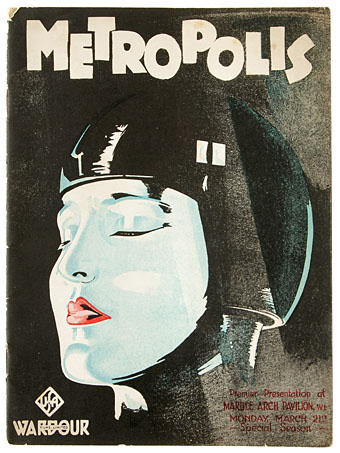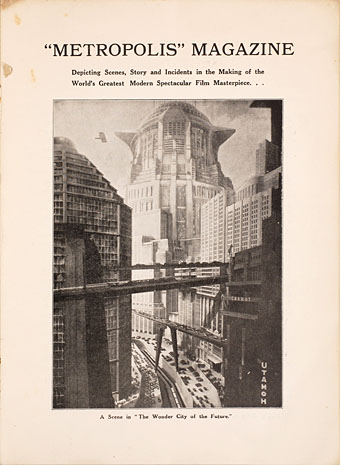When Fritz Lang’s Metropolis was released in Britain the distributors, Wardour Films Ltd, produced a 32-page guide to the film filled with production stills and brief pieces written by the cast and crew. I have a facsimile copy of this publication, a limited reprint by Phantasm Press, but the original document is also available for reading or downloading at the Internet Archive. Publications like this were the standalone equivalent of promotional pieces created for the readers of film magazines; Metropolis was Ufa’s most expensive production to date so there would have been a need for serious promotion.
None of this effort helped make the film a success, however. Lang’s epic is a masterpiece of direction and production design but Thea von Harbou’s script was the kind of absurd and naive fare you often get from writers incapable of projecting the complexities of the present day into their visions of the future. (HG Wells was unsparing in his review of “the silliest film”.) A lack of audience enthusiasm prompted foreign distributors to take out their editing scissors, but cutting a quarter of the footage didn’t help either, especially when the cuts made nonsense of the motivations of Rotwang the inventor. One thing you can see in the programme is shots from sequences like the race-track scene which were subsequently removed and wouldn’t be seen in anything other than still form for many decades.
Previously on { feuilleton }
• Blade Runner vs Metropolis
• The Metropolis of Tomorrow by Hugh Ferriss
• Metropolis!
• Metropolis posters



The Best Illustrated Edition
>http://www.kaluta.com/pages/metropolis/metbook.html
Meanwhile:
Well…we used to be able to dock our airship on top
>https://en.wikipedia.org/wiki/Industrial_National_Bank_Building#/media/File:Bank_of_America_Building,_Providence,_night.jpg
Here’s to a CYCLOPEAN Future…
Oh yeah, Kaluta’s illustrated edition is marvellous, probably more than the novel deserves.
My favorite scene in the film AND novel…
“And through the silence which did not dare to breathe rang the sound of a flute. Death was playing. The minstrel was playing the song which nobody plays after him, on his flute which was a human bone.
“The ghostly minstrel stepped from out his side-niche, carved in wood, in hat and wide cloak, scythe on shoulder, the hour-glass dangling from his girdle. Playing his flute, he stepped out of his niche and made his way through the cathedral. And behind him came the seven Deadly Sins as the following of Death.”